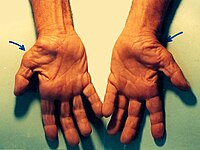
Photo from wikipedia
Supplemental Digital Content is available in the text. Background: Management of suspected scaphoid fractures includes repeated evaluation and casting in symptomatic patients with nondiagnostic radiographs. In this systematic review and… Click to show full abstract
Supplemental Digital Content is available in the text. Background: Management of suspected scaphoid fractures includes repeated evaluation and casting in symptomatic patients with nondiagnostic radiographs. In this systematic review and meta-analysis, the authors compare the diagnostic accuracy of clinical examinations for scaphoid fractures and create a decision guide using Bayesian statistics. Methods: The MEDLINE, Embase, and Cumulative Index to Nursing and Allied Health Literature databases were queried for studies that evaluated clinical index tests and their diagnostic accuracies for scaphoid fracture. Summary estimates were achieved by a bivariate random effects model and used in Bayes’ theorem. The authors varied the scaphoid fracture prevalence for sensitivity analysis. Results: Fourteen articles with 22 index tests and 1940 patients were included. Anatomical snuffbox pain/tenderness (11 studies, 1363 patients), pain with axial loading (eight studies, 995 patients), and scaphoid tubercle tenderness (five studies, 953 patients) had sufficient data for pooled analysis. Anatomical snuffbox pain/tenderness was the most sensitive test (0.93; 95 percent CI, 0.87 to 0.97), and pain with axial loading was the most specific test (0.66; 95 percent CI, 0.41 to 0.85), but all three tests had lower estimated specificities compared with sensitivities. In the base case, the probability of fracture was approximately 60 percent when a patient presented with all three findings after acute wrist injury. Conclusions: The posttest probability of scaphoid fracture was sensitive to both prevalence and diagnostic accuracy of individual clinical index tests. In a population with a fracture prevalence of 20 percent, patients presenting with concurrent anatomical snuffbox pain/tenderness, pain on axial loading, and scaphoid tubercle tenderness may benefit from early advanced imaging to rule out scaphoid fractures if initial radiographs are nondiagnostic. CLINICAL QUESTION/LEVEL OF EVIDENCE: Diagnostic, II.
Journal Title: Plastic and Reconstructive Surgery
Year Published: 2021
Link to full text (if available)
Share on Social Media: Sign Up to like & get
recommendations!